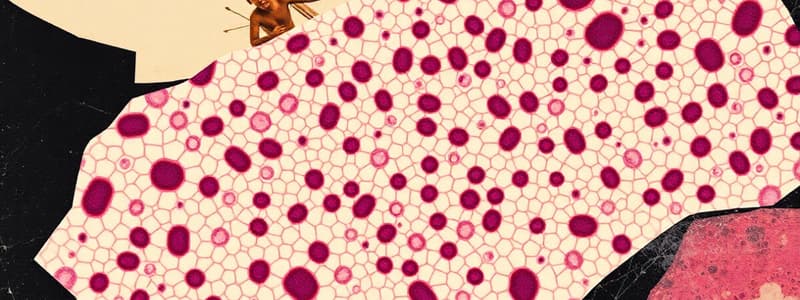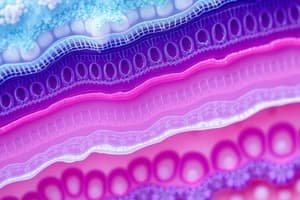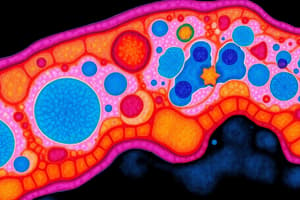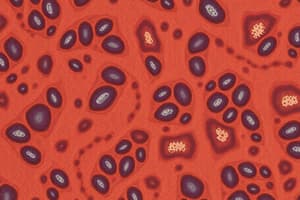Podcast
Questions and Answers
Which of the following is NOT a function of stratified columnar epithelium?
Which of the following is NOT a function of stratified columnar epithelium?
- Muscle contraction (correct)
- Absorption
- Secretion
- Protection
Which of the following epithelial tissues is characterized by multiple layers of cells that can stretch and change shape?
Which of the following epithelial tissues is characterized by multiple layers of cells that can stretch and change shape?
- Stratified cuboidal epithelium
- Stratified squamous epithelium
- Transitional epithelium (correct)
- Stratified columnar epithelium
Which of the following locations is NOT a site where you would find stratified squamous epithelium?
Which of the following locations is NOT a site where you would find stratified squamous epithelium?
- Skin
- Esophagus
- Mouth
- Small intestine (correct)
Epithelial tissues play a role in the movement of substances. Which specific type of epithelial cell is responsible for this function through the use of cilia?
Epithelial tissues play a role in the movement of substances. Which specific type of epithelial cell is responsible for this function through the use of cilia?
Which of the following is an example of a specialized structure found in epithelial tissues that is involved in secretion?
Which of the following is an example of a specialized structure found in epithelial tissues that is involved in secretion?
What characteristic of epithelial tissue refers to the orientation of its surfaces?
What characteristic of epithelial tissue refers to the orientation of its surfaces?
Which epithelial tissue type is specialized for stretching and is found in organs like the bladder?
Which epithelial tissue type is specialized for stretching and is found in organs like the bladder?
Which type of simple epithelium is primarily involved in secretion and absorption?
Which type of simple epithelium is primarily involved in secretion and absorption?
What is a key feature of stratified squamous epithelium?
What is a key feature of stratified squamous epithelium?
What term describes the lack of blood vessels in epithelial tissues?
What term describes the lack of blood vessels in epithelial tissues?
Where would you typically find simple squamous epithelium in the human body?
Where would you typically find simple squamous epithelium in the human body?
Which characteristic of epithelial tissue allows for sensations through a rich supply of nerve endings?
Which characteristic of epithelial tissue allows for sensations through a rich supply of nerve endings?
What type of epithelium appears to be multilayered but is actually a single layer of cells due to differing heights?
What type of epithelium appears to be multilayered but is actually a single layer of cells due to differing heights?
Flashcards
Stratified Squamous Epithelium
Stratified Squamous Epithelium
A type of epithelial tissue with multiple layers of flattened, scale-like cells. It's tough and waterproof, protecting against abrasion and pathogens.
Stratified Cuboidal Epithelium
Stratified Cuboidal Epithelium
A type of epithelial tissue with multiple layers of cube-shaped cells. It provides protection and is found in glands.
Stratified Columnar Epithelium
Stratified Columnar Epithelium
A type of epithelial tissue with several layers of cells, including tall columnar cells at the surface. It's great for both protection and secretion, like a fortress with guards!
Transitional Epithelium
Transitional Epithelium
Signup and view all the flashcards
Additional Functions of Epithelial Tissues
Additional Functions of Epithelial Tissues
Signup and view all the flashcards
Simple Squamous Epithelium
Simple Squamous Epithelium
Signup and view all the flashcards
Simple Cuboidal Epithelium
Simple Cuboidal Epithelium
Signup and view all the flashcards
Simple Columnar Epithelium
Simple Columnar Epithelium
Signup and view all the flashcards
Pseudostratified Epithelium
Pseudostratified Epithelium
Signup and view all the flashcards
Cellularity of Epithelial Tissue
Cellularity of Epithelial Tissue
Signup and view all the flashcards
Polarity of Epithelial Tissue
Polarity of Epithelial Tissue
Signup and view all the flashcards
Avascular Nature of Epithelial Tissue
Avascular Nature of Epithelial Tissue
Signup and view all the flashcards
Study Notes
Epithelial Tissue Classification
- Classified by number of cell layers:
- Simple epithelium: One layer of cells
- Stratified epithelium: Multiple layers of cells
- Pseudostratified epithelium: Appears layered due to varying cell heights, but all cells contact the basement membrane.
- Classified by cell shape:
- Squamous: Flat, thin cells
- Cuboidal: Cube-shaped cells
- Columnar: Taller than wide, resembling columns
- Transitional: Specialized for stretching, found in organs like the bladder
Epithelial Tissue Characteristics
- Cellularity: Tightly packed cells with minimal extracellular material
- Polarity: Apical (top) surface exposed to body's exterior, basal (bottom) surface attached to underlying tissue
- Avascular: No blood vessels; relies on diffusion for nutrients
- Innervated: Contains nerve supply for sensation
- Regenerative: High capacity to replace damaged or dead cells
Types of Epithelial Tissue
Simple Squamous Epithelium
- Structure: Single layer of flat cells
- Function: Facilitates diffusion and filtration
- Location: Alveoli of lungs, blood vessels (endothelium), glomeruli of kidneys
Simple Cuboidal Epithelium
- Structure: Single layer of cube-shaped cells
- Function: Secretion and absorption
- Location: Kidney tubules, glandular ducts, surface of ovaries
Simple Columnar Epithelium
- Structure: Single layer of tall, column-like cells
- Function: Absorption and secretion of mucus and enzymes
- Location: Digestive tract (stomach, intestines), gallbladder, certain glands
Stratified Squamous Epithelium
- Structure: Multiple layers of cells, flattened cells at surface
- Function: Protection against abrasion and pathogens
- Location: Skin (keratinized), mouth, esophagus, vagina (non-keratinized)
Stratified Cuboidal Epithelium
- Structure: Multiple layers of cube-shaped cells
- Function: Protection
- Location: Sweat glands, mammary glands, salivary glands
Stratified Columnar Epithelium
- Structure: Several layers with column-shaped cells at surface
- Function: Protection and secretion
- Location: Parts of male urethra, large ducts of some glands
Transitional Epithelium
- Structure: Multiple layers of cells that can stretch and change shape
- Function: Allows for expansion and contraction
- Location: Urinary bladder and ureters
Additional Epithelial Tissue Functions
- Secretion: Glands secrete substances like enzymes, hormones, and mucus
- Absorption: Nutrients absorbed from the environment
- Protection: Epithelial layers protect underlying tissues
- Transcellular Transport: Movement of substances across epithelial cells
- Sensation: Nerve endings detect sensory input
- Movement: Cilia aid in moving substances along surfaces
Studying That Suits You
Use AI to generate personalized quizzes and flashcards to suit your learning preferences.




